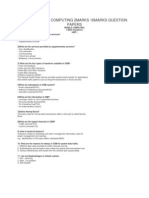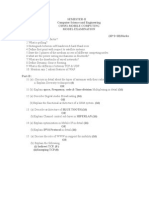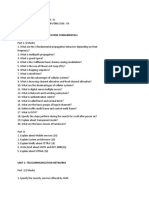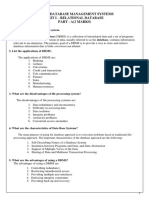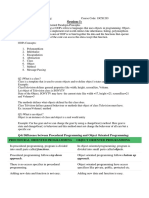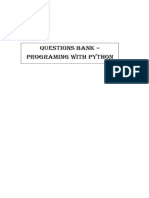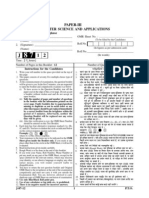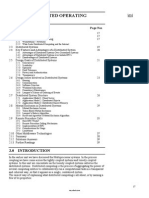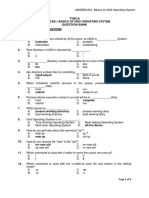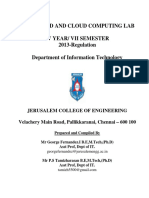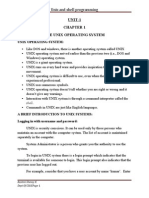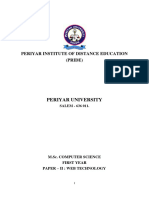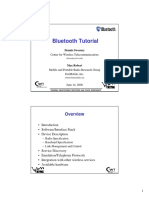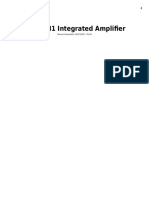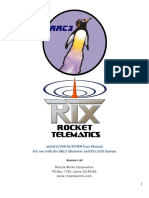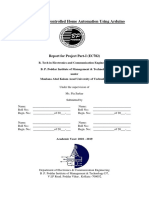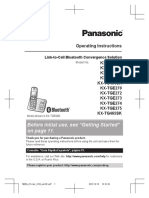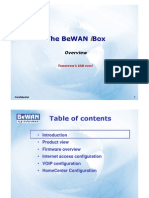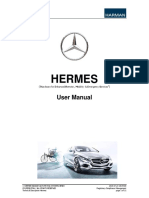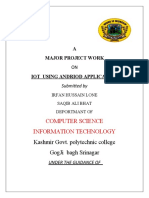Cs 72 Mobile Computing 2 Mark Questions Unit I 1) What Are The Categories of Mobile Services?
Cs 72 Mobile Computing 2 Mark Questions Unit I 1) What Are The Categories of Mobile Services?
Uploaded by
Rama SubramanianCopyright:
Available Formats
Cs 72 Mobile Computing 2 Mark Questions Unit I 1) What Are The Categories of Mobile Services?
Cs 72 Mobile Computing 2 Mark Questions Unit I 1) What Are The Categories of Mobile Services?
Uploaded by
Rama SubramanianOriginal Description:
Original Title
Copyright
Available Formats
Share this document
Did you find this document useful?
Is this content inappropriate?
Copyright:
Available Formats
Cs 72 Mobile Computing 2 Mark Questions Unit I 1) What Are The Categories of Mobile Services?
Cs 72 Mobile Computing 2 Mark Questions Unit I 1) What Are The Categories of Mobile Services?
Uploaded by
Rama SubramanianCopyright:
Available Formats
CS 72 MOBILE COMPUTING 2 Mark Questions UNIT I 1) What are the categories of Mobile services?
Bearer services Tele services Supplementary services 2) What are the services provided by supplementary services? User identification Call redirection Call forwarding Closed user groups Multiparty Communication 3) What are the four types of handover available in GSM? 1.Intra cell Handover 2.Inter cell Intra BSC Handover 3.Inter BSC Intra MSC handover 4.Inter MSC Handover 4.What is meant by GPRS? The General Packet Radio Service provides packet mode transfer for applications that exhibit traffic patterns such as frequent transmission of small volumes. 5)What are subsystems in GSM system? Radio subsystem(RSS) Network & Switching subsystem(NSS) Operation subsystem(OSS)
6)What are the information in SIM? card type, serial no, list of subscribed services Personal Identity Number(PIN) Pin Unlocking Key(PUK) An Authentication Key(KI)
7)Define Normal Burst? The frame used for normal data transmission within a time slot is called Normal Burst.
8)What are the logical channels in GSM? Traffic channel(TCH) Control channel(CCH) 9) what is meant by beacon? A beacon contains a timestamp and other management information used for power management and roaming. e.g., identification of the base station subsystem(BSS) 10. What are the reasons for delays in GSM for packet data traffic. 1. Different data rates provided by traffic channels are low. 2. Authentication and encryption also makes the packet data transmission low. 3. Various interferences and noises from the channel also causes delay. 11. List out disadvantages of cellular system. 1. Self jamming 2. Near far problem 3. Soft Handoff 12. How much of the original GSM network does GPRS need. Which elements of the network perform the data transfer. GPRS is an enhancement of SM. It uses same physical channel as GSM and only new logical GPRS radio channels are defined. Elements needed for data transfer: 1. GPRS support nodes (GSN) 2. Gate way GPRS Support Node (GGSN) 3. Servicing GPRS Support Node (SGSN) 4. GPRS Register (GR) 13. Explain the various entities available in radio subsystem 1. BSS: It performs all function necessary to maintain radio connections to a MS. 2. BTS: It comprises all radio equipments 3. BSC: It basically manage BTSs. 4. MS: It comprises all user equipment and software needed for communication within a GSM network. 14. . Explain the various entities available in NSS. NSS consist of following switches and databases. 1. MSC: They setup connection to other MSCs and to BSCs via A interface. 2. HLR: It is the most important data base which stores all user relevant information.
3. VLR: It is a dynamic data base which stores all important information needed for MS users currently in the LA that is associated to MSC. 15. Explain the various systems available in Operation Subsystem. Operating subsystem : It contains necessary functions for network operation and maintenance. 1. OMC: It manages traffic monitoring , accounting and billing 2. AuC: It is used to protect user identity and data transmission. 3. EIR: It stores all device identifications registered for this network. 16. Explain the various control channels available in GSM. 1. BCCH: A BTS uses this channel to signal information to all MSs with in a cell. 2. CCCH: All information regarding connection setup between MS and BS are exchanged via CCCH. 3. DCCH: It is used to exchange large amounts of data in less time. 17.) What is mobile routing? Even if the location of a terminal is known to the system, it still has to route the traffic through the network to the access point currently responsible for the wireless terminal. 18) What are the functions which support service and connection control? >Access point control function >Call control and connection control function >Network security agent >Service control function >Mobility management function 19. If 8 speech channels are supported on a single radio channel, and it no guard band is assumed, what is the number of simultaneous users can be accommodated in GSM? A time slot is GSM can only be used by one user to transmit or receive during one of the transmission (radio) channel. That is, we can accommodate 1 user in one time slot. Therefore, for 8 speech channels we can accommodate 8 simultaneous users in GSM.
20. Define Base Station Subsystem GPRS protocol (BSSGP). The Base Station Subsystem GPRS protocol (BSSGP) is used to convey routing and QoSrelated information between the BSS and SGSN. BSSGP not perform error correction and works ontop of a Frame Relay (FR) network.
UNIT II 1. What is the primary goal of IEE 802.11? The primary goal of the standard was the specification of a simple, robust, WLAN which offers time bounded and asynchronous services also it should be able to operate with multiple physical layers. 2) What are Advantages of wireless LAN? Flexibility, Planning, Design, Robustness, Quality Service, Cost, Proprietary Solution, Restriction, Safety and Security 3) What are Design Goals of Wireless LAN? Global Operation Low Power License-free Operation Robust transmission technology Simplified spontaneous co-operation Easy to use protection of investment Safety and Security Transparency for application 4)What are the three Low Power States provided by Bluetooth? PARK state HOLD state SNIFF state 5) What are the examples for service scenarios identified in WATM ? >Office environments >Universities, schools, training, centres >Industry >Hospitals >Home >Networked vehicles 6) What are the different network types of BRAN? >Hyperlan1 >Hyperlan2 >Hyper access >Hyperlink
7) What is the main problem for WATM during handover? The main problem for WATM during the handover is rerouting of all connections and maintaining connection quality. 8. Why is the physical layer IEEE 802.11 subdivided. Physical layer is subdivided into , PLCP (physical layer convergence protocol) . It provides a carrier sense signal called CCA (Clear channel assessment) and provides a common PHY Service Access Point SAP independent of transmission technology. PMD : Physical Medium Dependent Sublayer: It handles modulation and encoding / decoding of signals. 9. How is mobility restricted using WLANs. WLAN: Mobile restricted with respected to the access point. When moving the mobile entity needs to change network access point. Every moblile entity (Person, terminal) must have its own identity. An identifier is assigned uniquely to one mobile entity. 10. What is HIPERLAN? HIper Performance Radio LAN : HIPERLAN It is a new standard for radio LAN developed by ETIS. Offers interoperability standard which specifies a common air interface. EITS developed a standard that would be equivalent in performance to wired LAN such as Ethernet. 10) What is EY-NMPA? Elimination yield Non Pre-emptive Multiple Access (EY-NMPA) is a scheme which uses several phases to sense the medium. Access the medium and for contention resolution.. Priority schemes can also be included. This is actually used in HIPERLAN1 specification 11. Is IEEE 802.11 and Wi-Fi same. State the purpose of WiFi. No, IEEE 802.11 and Wi-Fi are different. IEEE 802.11 is a Wireless LAN (WLAN). Where as, Wi-Fi uses WPA ( Wi-Fi Protected Access) to accelerate the introduction of strong security into WLANs. WPA use the security mechanisms of IEEE 802.11i. In other words it is a security mechanism in WLAN, which dealt about authentication, key management, and data transfer privacy. 12. Why Bluetooth specification comprises so many protocols and components? Bluetooth specification comprises so many protocols and components because, The protocol stack of Bluetooth can be divided into a
1.
Core Specification, which describes the protocols from the physical layer to the data link control together with management functions.
2. Profile specification, which describes the protocols and functions needed to adopt the wireless Bluetooth technology to legacy and new applications. 13. What are the different phases in HIPERLAN? The different phases in HIPERLAN are 1. Prioritization phase 2. Contention phase, and 3. Transmission phase. 14. What is scatternet? One Bluetooth device can operate simultaneously on two piconets, acting as a bridge between the two. A Conglomeration of two or more piconets is called a scatternet. 15. What are the elements of Bluetooth core protocols? The elements of Bluetooth core protocols are 1. Radio.
2. Base band, 3. Link manager protocols, 4. Logical link control & adaptation protocol (L2CAP) 5. Survive discovery protocol. 16. List the two types of data bursts specified by HIPERLAN. The two types of data bursts specified by HIPERLAN are, 1. LBR HBR data burst
2. LBR data burst. 17. Define Roaming. If a user walks around with a wireless station, the station has to move from one access point to another to provide uninterrupted service. Moving between access point is called Roaming. The term handover and handoff is used in the context of mobile or cellular system would be more appropriate as it is simply a change of the active cell.
18. What are the phases in Elimination yield Non Pre-emptive Multiple Access (EY-NMPA). Elimination yield Non Pre-emptive Multiple Access (EY-NMPA) divides the medium access of different competing nodes into three phases: 1. Prioritization : Determine the highest priority of a data packet ready to be sent by competing nodes. 2. Contention : Eliminate all but one of the contenders , if more than one sender has the highest current priority. 3. Transmission: Finally, transmit the packet of the remaining node. 19. What are the general extention of ATM. 1. Location Management 2. Mobile Routing 3. Handover Signalling 4. Qos and traffic Control 5. Network Management 20. Example for WATM. 1. Office Environment 2. Universities, schools, training centers\ 3. Industry 4. Hospitals 5. Home 6. Networked vehicles etc.
CS 72 MOBILE COMPUTING 2 Mark Questions UNIT III 1. What is mobile routing? Even if the location of a terminal is known to the system, it still has to route the traffic through the network to the access point currently responsible for the wireless terminal. Each time a user moves to a new access point, the system must reroute traffic. This is known as mobile routing. 2) What are the functions which support service and connection control? >Access point control function >Call control and connection control function >Network security agent >Service control function >Mobility management function 3) What is mobile terminal and wireless terminal?. Mobile terminal is a standard ATM terminal with the additional capability of reconnecting after access point change. the terminal can be moved between different access point within a certain domain. Wireless terminal is accessed via a wireless link, but the terminal itself is fixed, i.e., the terminal keeps its access point to the network 4) What is generic routing encapsulation? Generic routing encapsulation (GRE) is an encapsulation scheme which supports other network protocols in addition to IP. It allows the encapsulation of packets of one protocol suite into the payload portion of a packet of another protocol suite. 5) Define COA. The COA (care of address) defines the current location of the MN from an IP point of view. All IP packets sent to the MN are delivered to the COA, not directly to the IP address of the MN. Packet delivery toward the MN is done using the tunnel. 6) What is meant by Transparency? Mobility should remain invisible for many higher layer Protocols and applications. The only affects of mobility should be a higher delay and lower bandwidth which are natural in the case of mobile networks. 7)What is Binding Request? Any node that wants to know the current location of an MN can send a binding request to the HA. The HA can check if the MN has allowed dissemination of its current location.
8) What are the possibilities for the location of care-of-address (COA)? The two possibilities for the location of care-of-address are: i.Foreign agent COA ii.Co-related COA 9) What is COA? Care Of Address (COA) define the current location of the MN (Mobile Node) from an IP point of view. DHCP is a good candidate for supporting the acquisition of Care Of Addresses. 10) What is Dynamic source Routing? Dynamic Source Routing eliminates all periodic routing updates. If a node needs to discover a route, it broadcast a route request with a unique identifier and the destination address as parameters. Any node that receivers a route request gives a list of addresses representing a possible path on its way toward the destination. 11) Why is need of routing? Routing is to find the path between source and destination and to forward the packets appropriately. 12) Define Mobile node: Mobile node: A mobile node is an end-system or router that can change its point of attachment to the Internet using mobile IP. The MN keeps its IP address and can continuously with any other system in the Internet as long as link layer connectivity is given. 13) What is Encapsulation and Decapsulation? Encapsulation is the mechanism of taking a packet consisting of packet header and data and putting it into the data part of a new packet. The reverse operation, taking a packet out of the data part of another packet,is called decapsulation. 14) Define Dynamic source routing. In an adhoc networks where nodes exchanges packets from time to time. Dynamic Source routing divides the task of routing into two separate problem i)Routing Recovery: A node only tries to discover a route to destination if it has to send something to this destination and there is currently no known route ii).Route Maintenance: If a node is continuously sending packets via route, it has to make sure that the route is held urgent. .As soon as a node detects problem with the current route it has to find an alternative node. 15. Define table driven routing protocol and on-demand routing protocol. Table driven routing is the DSDV routing protocol. Here distance vector is used as Routing Information Protocol. It works well in the addition of two fields. 1. Sequence number : Each routing advertisement comes with a sequence number. The sequence number will avoid loops. 2. Damping : Transient changes in topology that are of short duration should destabilise the routing mechanisms. The advertisement that contain the temporary changes are not disseminated. A node works with dissemination if the changes are temporary.
16. Define on-demand routing protocol. The routing is done by two separate problem. 1. Route Discovery: A nods tries to discover a route to a destination only if it has a packet to send and currently there is no route between the source and destination. 2. Route Maintenance: If a node is continuously sending packets via a route, it has to make sure that the route is held upright. As soon as a node detects the problems with current route, it has to find an alternate route. 17. Why is routing and mobility are important issues of an adhoc network. Mobility is the greatest problem for routing in adhoc network, because there are frequent changes in topology, so snap shot is valid for very short period of time. Routing is difficult because of the asymmetric link. 18. Give the purpose of reverse tunneling When the MN sends packets to CN reverse tunnel is needed because, a. Firewalls: all the network is connected to internet via firewall. The firewall will filter the packet from malicious address. b. Multicast: Reverse tunnel is needed for mobile node to participate in a multicast group c. TTL: A mobile node sense a packet with a certain TTL and still in the home network itself. When the MN has moved to FN this TTL is very low and will not reach the destination. 19. Give any two reasons for why routing in mobile ad hoc networks complicated? Routing is complicated because of 1. Asymmetric links 2. Redundant links 3. Interference 4. Dynamic topology 20. What is tunneling? Tunneling is used to forward packets between HA and COA. Tunnel establishes a virtual pipe for the data packets between tunnel entry and end point. Tunnel is nothing but sending packet through tunnel using encapsulation
CS 72 MOBILE COMPUTING 2 Mark Questions
UNIT IV 1) What are the requirements for the development of mobile IP standard? The requirements are: a. Compatibility b. Transparency c. Scalability and efficiency d. Security 2) What are the two functions of the transport layer in the internet? The two functions of the transport layer in the internet are check summing over user data and multiplexing de-multiplexing of data from applications. 3) What is called the exponential growth of the congestion window? The sendor always calculate congestion window for a window start size of the congestion window is one segment. Sender sends one packet and waits for acknowledgement. If acknowledgement arises it raises the level of congestion window by one. If sender sends two packet if acknowledgement arrises it raises the level of congestion window by two. This scheme raises the level of congestion window every time the acknowledges come back, which takes roundtrip time(RTT).This is called the exponential growth of the congestion window. 4) Advantages of I-TCP: I-TCP does not require any changes in the TCP protocol as used by the hosts in the fixed network or other hosts in a wireless network that do not use this optimization. Without partitioning retransmission of lost packets would take place between mobile host and correspondent host across the whole network. Optimization of new mechanisms is quite simple to be done in I-TCP as they only cover a single hop. The short delay between the mobile host and foreign agent can be determined and is independent of other traffic streams. Therefore an optimized TCP can use precise time-outs to guarantee retransmission as fast as possible. Partitioning into two connections also allows the use of a different transport layer protocol between the foreign agent and the mobile host or the use of compressed headers etc. The foreign agent can act as a gateway to translate between different protocols. 5) Disadvantages of I-TCP:
The loss of the end to end semantics of TCP cause problems if the foreign agent portioning the TCP connection crashes. An increased handover latency is more problematic in practical use. The foreign agent must be a trusted entity because the TCP connections end at this point. 6. What is WAP? Wireless application protocol(WAP) is a common effort of many companies and organizations to set up a framework for wireless and mobile web access using many different transport systems. Eg. GSM, GPRS, UMTS 7) What is WMLBrowser? WMLBrowser is a library that provides several functions typical for a browser, such as prev to go back one card or refresh to update the context of the user interface. 8) Define WAP WAP is Wireless Application Protocol.It is the basic Objetive of the WAP forum are to bring diverse Internet content and others data service to digital cellular phones and other wireless,mobile terminals.Moreever a protocol suite should enable global wirless communication across different wireless network technologies. All WAP forum solution must be:interoperable,scaleable,efficient,reliable. 9)What is HTTP? The Hypertext transfer protocol is a stateless, lightweight, application level protocol for data transfer between servers and clients. An HTTP transaction consists of an HTTP request issued by a client and an HTTP response from the server. Stateless means that all HTTP transactions independent of each other. 10) What are the Advantages of MobileTCP? Advantage: i. M-TCP maintains the TCP end-to-end semantice. The SH does not send any ACK itself but forwards the ACKs from the MH. ii.If the MH is disconnected, M_TCP avoids useless retransmissions, slow starts or breaking connections by simply shrinking the senders window to 0. iii. Since M-TCP does not buffer data in the SH as I-TCP does, it is not necessary to forward buffers to a new SH. Lost packets will be automatically retransmitted to the new SH. 11) What are the Disadvantages of MobileTCP? Disvantage: i. As the SH does not act as proxy as in I-TCP, packet loss on the wireless link due to bit errors is propagated to the sender. M-TCP assumes low bit error rates, which is not always a valid assumption.
ii. A modified TCP on the wireless link not only requires modification to the MH protocol software but also new network elements like the bandwidth manager. 12) What is Fast retransmit? In TCP, a receiver sends acknowledgements only if it receive any packets from the sender. Thus receiving acknowledgements from a receiver shows additionally that the receiver continuously receives something from the sender. Therefore, the gap in the packet stream is not due to severe congestion, but a simple packet loss due to a transmission error. The sender can now retransmit the missing packets before the timer expires. This behaviour is called fast retransmit. 13) Define fast retransmit? The gap in the packet stream is not due to severe congestion, but a simple packet loss due to a transmission error. The sender can now retransmit the missing packet before the timer expires. This behavior is called fast retransmit. 14) What is fast recovery? The receipt of acknowledgement shows that there is no congestion justifying a slow start. The sender can continue with the current congestion window. The sender performs a fast recovery from the packet loss. This mechanism can improve the efficiency of TCP dramatically. 15)What is image scaling? If a page contains a true color, high-resolution picture, this picture can be scaled down to fewer colors, lower resolution, or finally to only the title of the picture. The user can decide to download the picture separately. Further one can offer clipping, zooming, or detail studies to users if they are interested in a part of the picture. 16. What are the solutions for the problem with HTTP and HTML? HTTP 1. Bandwidth delay HTML High performance system High Resolution Display Mouse,.sound system, large hard disk
2. Caching 3. POST
17. Give tha basic objectives of WAP? To provide 1. Internal content access to mobile phones
2. Data Services 3. Protocol suite for global wireless communication across the different technologies.
18. Give any two capabilites of WML script that is not supported by WML. 1. Validity check for user input. 2. Access to device facilities. 3. Local user interaction 4. Extension to device software.
19. Mention a few WCMP messages. 1. Destination unreachable 2. Parameter problem 3. Message too big 4. Reassembly failure and Echo Request/Reply.
20. Objectives of OMA (Open Mobile Alliance). 1. Internet content like webpages and push services. 2. Data Services 3. Protocol suite for global wireless communication across the different technologies. 4. Interoperable, scalable, efficient, Reliable and secure.
UNIT V 1. What is pervasive computing? Pervasive computing is also called as ubiquitous computing is the trend toward embedding micro processors in everyday objects so that they can communicate information. It refers to the computer contained in common place so that people are unaware of their presence. All these devices communicate with each other over wireless networks without any interaction required by the user.
2. Pervasive computing is a combination of 3 technologies a) Micro -electronic technology This technology provides small powerful device and display with low energy consumption. b) Digital communication technology The technology provides higher bandwith, high data transfer rate at lower cost and World Wide roaming. c) The International standardization This standardization in done through standardization bodies and industry to provide the frame works for integrating all components into an interoperable system with security, service and billing systems. 3. Technologies used in 3G mobile systems a) GSM/UMTS b) imode system GSM/UMTS This technology is based on the harmonized 3G Radio interface. This system is supported by major telecom standard organization. The service offered are World Wide roaming, supports WAP and seamless integration from GSM to UMTS IMODE SYSTEM
This system was developed by NTT Docomo. This is proprietary system. The concepts used are high speed, packet switched network and IP.
The system was developed in Japan and now being used by others. 4. Strength of GSM. 1. Supported by major standard organization suppliers. 2. Has large user base. Strength of IMODe 1. Maturity.
2. Rich set of application. 3. Affinity of internet with respect to protocol and content representation. 4. Uses CHTML ie compact hypertext markup language , easy to migrate from internet application to mobile applications. 5. DSTN 1. Dual scan DSTN is generally used in PDA. 2. This method controls display element via passive matrix addressing. 3. This method consumes less power 4. Has superior display performance hence used in laptops. 6.Techniques followed in Smart phone and PAD. 1. They store their OS code and application data in non- volatile flash memory and battery backed RAM. 2. They are based on semi conductor techonology. 3. Hence they need less power and provide faster access. 4. The capacity is from 2 to 16 MB. 5. Expansion slots are available for additional to be plugged in. Flash memory and static RAM can be used, frequently changed data is kept in SRAM.
7.Crusoe Processor. The power saving technology attempts to reduce the total number of transistor and replaced function by software. Such provides better performance by consuming less power. E.g. Crusoe processor by transmitter. This processor is very small processor designed as 128 bit very long instruction word (VLIW). The processor is capable of executing up to 4 operations per cycle.
8. Define FAR and FRR. False Acceptance Rate( FAR) is defined as the probability that the system will accept a wrong user. False Rejection Rate (FRR) is defined as the probability that the system will reject a correct user. For a SIM with PIN the FAR=0.01%
FRR= 0%. 9. OS Functionality. 1. User interface: Graphical Input/ Output. 2. Memory Management: Database, space, runtime systems, variables. 3. System Management: Events, alarms, data, time. 4. Communication layer: Communication via a. TCP/IP b. InfraRed.
10. Define Wireless Protocols. In these protocols no cables are needed inorder to communicate with each other devices. E.g. of wireless protocols are OBEX, IrDA, Bluetooth, 802.11B. 11. Characteristics of Bluetooth. 1. Frequency band. Bluetooth operates in the 2.45 GHz ISM band. 2.Security. Security mechanism is defined by the Bluetooth. 3.Transmitting Capabilities. Bluetooth is one directional and range is up to 10m. The transmitting services supplied are synchronous and asynchronous. 4. Bandwidth. The bandwidth is up to 1Mbps. 5. Speech The Bluetooth supports 3 digital channels simultaneously. 6. Cost: Bluetooth is expensive.
12. Compare the Generations of mobile systems. Generations Protocol TECHNOLOGY SPEECH QUALITY BANDWIDTH SECURITY 1G AMPS, C-Net 2G 2+G 3G UMTS,WCDMA
GSM,TDMA,CDMA GPRS, HSCSD,EDGE
Analogy Circuit Digital Circuit -Switched Switched POOR LOW None HIGH LOW
- Digital Circuit or Digital packet packet Switched Switched HIGH MEDIUM HIGH HIGH HIGH
Depending on HIGH protocol ,Low to high
14. Why IPV4 cannot be used with mobile devices. IPV4 has the constraints that the devices are stationary when there are mobility the devices attaches with new point of attachment with the different IP address. Then the connection with the old address will be broken. Mobile IP provides a way to solve the problem and tells how to mobile devices can communicate over IPV4. 15. Features of Mobile IPV6. 1. Auto Configuration and neighbour discovery. 2. With the use of above a mobile node can create or obtain a topologically correct CoA for the current point of attachment without the need of FA. 3. Strong encryption and authentication features. 4. Supports greater degree of mobility when compared with IPV4. 5. Mobility transparency is yet to achieve.
16. Define IP Addressing. A device wishing to join UPnP network should get an IP address. To get the address there are two methods.
1. Using DHCP. 2. Using Auto IP. The devices sends a requests to the DHCP server. If no server answers the request within a reasonable time then the device uses AutoIP to generate an IP address from the set of reserved IP addresses. 17. Define the concepts of Security. 1. Identification. 2. Authentication. 3. Authorization. 4. Transaction authorization. 5. Non-repudiation. 18. Define Authentication. Authentication is to prove that who the individuals say they are . The most common Authentication is user ID and Password. Authentication can also be done by SIM. The Authentication is executed between the SmartCard on the client and the Authentication software on the server side. Password provided by the user has to be given to the smart Card before a signature can be obtained to ensure Authentication. 19. Define TAN (Transaction Authorization Numbers). They are secret numbers delivered to the legitimate user in blocks. The organization that sends the TAN to the user ensure that users are aware of TAN upon the receipt of the TAN the user must acknowledge and sign stating that they will keep the TAN blocks secretly and never reveal to any one. 20. Challenges of Device Management. 1. Tracking device location. 2. Device-user relationship (Single owner or multiple owner) 3. Version control of devices and software 4. Software updates of existing devices. 5. Installation of new software on existing devices. 6. Providing secure access to device information.
You might also like
- It1402 Mobile Computing 2Document24 pagesIt1402 Mobile Computing 2bhrathikNo ratings yet
- Client Server Architecture A Complete Guide - 2020 EditionFrom EverandClient Server Architecture A Complete Guide - 2020 EditionNo ratings yet
- Mobile Computing EEM 825/ PEE411 Credits:4: SyllabusDocument6 pagesMobile Computing EEM 825/ PEE411 Credits:4: SyllabusGaurav Jaiswal100% (1)
- MPCDocument17 pagesMPCBoova RagavanNo ratings yet
- Cs9251 Mobile Computing 2marks 16marks Question PapersDocument11 pagesCs9251 Mobile Computing 2marks 16marks Question PapersNivithaNo ratings yet
- Cs9251 Mobile Computing 2marks 16marks Question PapersDocument11 pagesCs9251 Mobile Computing 2marks 16marks Question PapersValar MathiNo ratings yet
- Question Bank WCDocument12 pagesQuestion Bank WCALEX SAGAR100% (2)
- Cs9251 Mobile ComputingDocument13 pagesCs9251 Mobile ComputingSenthil KumarNo ratings yet
- GCC QBDocument16 pagesGCC QBSherril Vincent100% (1)
- CS2402 QB mpc2Document10 pagesCS2402 QB mpc2Prabhavathi AadhiNo ratings yet
- It1402 QBDocument3 pagesIt1402 QBMunish RaghavanNo ratings yet
- Cs8079 - Hci QB Unit 5Document5 pagesCs8079 - Hci QB Unit 5Ramesh KumarNo ratings yet
- Unit-1 Wireless Communication FundamentalsDocument5 pagesUnit-1 Wireless Communication Fundamentalsgsathish09No ratings yet
- Cs6303 - Computer Architecture Question Bank Unit-I Overview & Instructions Part - A (2 MARKS)Document4 pagesCs6303 - Computer Architecture Question Bank Unit-I Overview & Instructions Part - A (2 MARKS)muza bashaNo ratings yet
- Cse-Vii-java and J2EE (10cs753) - Question PaperDocument4 pagesCse-Vii-java and J2EE (10cs753) - Question PaperAbhinav JhaNo ratings yet
- Computer Architecture 1Document6 pagesComputer Architecture 1Joby PaulNo ratings yet
- CS1302 - Computer NetworksDocument5 pagesCS1302 - Computer Networkslm_zakaria4420No ratings yet
- Cs8492 - Database Management Systems Unit I - Relational Database Part - A (2 Marks)Document27 pagesCs8492 - Database Management Systems Unit I - Relational Database Part - A (2 Marks)Dr.P.L. Rajarajeswari CSE departmentNo ratings yet
- Django: Writing Your First Django App, Part 2Document12 pagesDjango: Writing Your First Django App, Part 2morrocod8147No ratings yet
- QBDocument231 pagesQBRanjith RameshNo ratings yet
- For Unit 4 UsefulDocument107 pagesFor Unit 4 Usefulshilpa dirisala100% (1)
- DWDM Unit-3: What Is Classification? What Is Prediction?Document12 pagesDWDM Unit-3: What Is Classification? What Is Prediction?Sai Venkat GudlaNo ratings yet
- Introduction To Web Application FundamentalsDocument393 pagesIntroduction To Web Application Fundamentalspeterbotts40No ratings yet
- Cs9251 Mobile Computing Question BankDocument16 pagesCs9251 Mobile Computing Question BankNivitha100% (1)
- Q1. Explain JDK, JRE and JVM?Document21 pagesQ1. Explain JDK, JRE and JVM?Bogdan BasilescuNo ratings yet
- Java Session NotesDocument48 pagesJava Session NotesK SairamNo ratings yet
- Software Engineering QBDocument6 pagesSoftware Engineering QBKarthick ThiyaguNo ratings yet
- DBMS QBDocument4 pagesDBMS QBRavikumar KhilariNo ratings yet
- DBMS Interview Questions-Interview Questions and Answers-23340Document7 pagesDBMS Interview Questions-Interview Questions and Answers-23340Dapborlang MarweinNo ratings yet
- Unit I: Web and Internet Technologies (15A05605) III B.Tech II Sem (CSE)Document50 pagesUnit I: Web and Internet Technologies (15A05605) III B.Tech II Sem (CSE)Rock Suneel KumarNo ratings yet
- JavaDocument149 pagesJavaMuthu KumNo ratings yet
- Unit 1Document80 pagesUnit 1kingpaulrajNo ratings yet
- I B.Sc.,Python Lab (2023-2024)Document50 pagesI B.Sc.,Python Lab (2023-2024)v28992695No ratings yet
- Questions Bank - Programing With PythonDocument6 pagesQuestions Bank - Programing With PythonDeadly DevilNo ratings yet
- June-2012 (Computer Science) (Paper)Document12 pagesJune-2012 (Computer Science) (Paper)futuredata100No ratings yet
- Prog 1: Write C++ Programs To Implement The Stack ADT Using An ArrayDocument47 pagesProg 1: Write C++ Programs To Implement The Stack ADT Using An ArrayM Ravi KishoreNo ratings yet
- Distributed Operating SystemDocument24 pagesDistributed Operating Systembubun_metal100% (1)
- Dbms Unit4 SQL FinalDocument7 pagesDbms Unit4 SQL FinalDurga PandeyNo ratings yet
- Wrapper Classes Exercise: Cognizant Technology SolutionsDocument7 pagesWrapper Classes Exercise: Cognizant Technology SolutionsJeevan Sai MaddiNo ratings yet
- Computer Architecture MCQDocument8 pagesComputer Architecture MCQVishal ThakurNo ratings yet
- DSA - Question Bank - 2023Document4 pagesDSA - Question Bank - 2023trupti.kodinariya9810No ratings yet
- HCI FinalDocument17 pagesHCI FinalRavi BikkumallaNo ratings yet
- UNIX Question Bank - FinalDocument6 pagesUNIX Question Bank - FinalramalalliNo ratings yet
- It6713 Grid Cloud Computing LabDocument96 pagesIt6713 Grid Cloud Computing Labsmilingeyes_nicNo ratings yet
- Question Bank Format B.tech (CSe)Document5 pagesQuestion Bank Format B.tech (CSe)Jyoti SinghNo ratings yet
- Hadoop Online TrainingDocument7 pagesHadoop Online TrainingmsrtrainingsNo ratings yet
- Unix Command Unit 1Document40 pagesUnix Command Unit 1रवींद्र नलावडेNo ratings yet
- Unit-1 Intro To .Net FrameworkDocument77 pagesUnit-1 Intro To .Net FrameworkRahul GuptaNo ratings yet
- SRM Institute of Science and TechnologyDocument6 pagesSRM Institute of Science and TechnologySANJAY 06No ratings yet
- Paper - II Web TechnologyDocument248 pagesPaper - II Web TechnologyAhfrin JNo ratings yet
- Unix Course Material - Tata ElxsiDocument112 pagesUnix Course Material - Tata ElxsiRajesh BejjenkiNo ratings yet
- DWDM Unitwise QnsDocument3 pagesDWDM Unitwise QnsSaiCharanNo ratings yet
- Introduction To AJSDocument44 pagesIntroduction To AJSAmritha SankarNo ratings yet
- Operations Research Lecture 1: Introduction To OR Models: Kusum Deep Mathematics DepartmentDocument44 pagesOperations Research Lecture 1: Introduction To OR Models: Kusum Deep Mathematics DepartmentGunaseelan RvNo ratings yet
- Library Management SystemDocument31 pagesLibrary Management SystemFahim MuntasirNo ratings yet
- Unit-1 Question BankDocument4 pagesUnit-1 Question BankIndigoNo ratings yet
- Mobile Computing-Question With Answers SHORT NOTES MCDocument46 pagesMobile Computing-Question With Answers SHORT NOTES MCTauseef khan100% (3)
- Mobile Computing NotesDocument27 pagesMobile Computing NotesBishnu Das100% (3)
- Call Setup in A GSM NetworkDocument6 pagesCall Setup in A GSM NetworkluvdembadNo ratings yet
- Mobile Handset ArchitectureDocument18 pagesMobile Handset ArchitectureNhi TrangNo ratings yet
- Bluetooth Tutorial: Center For Wireless TelecommunicationsDocument46 pagesBluetooth Tutorial: Center For Wireless TelecommunicationsVêdhã RockNo ratings yet
- Hcia IotDocument96 pagesHcia Iothamza sassi100% (2)
- Nokia Bluetooth Mono Headset BH-310 User Guide: Issue 1.0Document12 pagesNokia Bluetooth Mono Headset BH-310 User Guide: Issue 1.0Anant JohriNo ratings yet
- SkytraxxDocument34 pagesSkytraxxEvgenNo ratings yet
- Valeport TideMaster V2aDocument1 pageValeport TideMaster V2aImran RazzaqNo ratings yet
- 2021 - P514a-H6 - UM-ENG ManualDocument51 pages2021 - P514a-H6 - UM-ENG ManualKIODIEGONo ratings yet
- HBH DS200 UG R1a Multilingual 1Document0 pagesHBH DS200 UG R1a Multilingual 1Johnny DoeNo ratings yet
- Škodaauto: Radio Navigation System AmundsenDocument38 pagesŠkodaauto: Radio Navigation System AmundsenstelianlazaroiuNo ratings yet
- En-Mea Nb100 Datas Jan09 LowDocument2 pagesEn-Mea Nb100 Datas Jan09 LowJeoNo ratings yet
- Spesifikasi Total Station Es 105Document2 pagesSpesifikasi Total Station Es 105Rizki Fahrudin UlinNo ratings yet
- Indoor Cam 2K Pan&Tilt Manual UsDocument10 pagesIndoor Cam 2K Pan&Tilt Manual UsStergios MoneosNo ratings yet
- Mobile Virus and SecurityDocument25 pagesMobile Virus and Securitymohitkhanna31No ratings yet
- Sony XAV-AX5110 ManualDocument72 pagesSony XAV-AX5110 Manualtranquyanh.bqldaNo ratings yet
- CXA61/81 Integrated Amplifier: Manual Generated: 19/07/2022 - 05:36Document36 pagesCXA61/81 Integrated Amplifier: Manual Generated: 19/07/2022 - 05:36nonameNo ratings yet
- 2022 Is The Year of The Low-Cost Bluetooth SpeakerDocument14 pages2022 Is The Year of The Low-Cost Bluetooth SpeakerNitish KumarNo ratings yet
- Hw-n300 ZP Fullmanual 00 Eng Spa 180713Document62 pagesHw-n300 ZP Fullmanual 00 Eng Spa 180713NIVARDO ÑAUPA MOROCCONo ratings yet
- mDACS USB-IO User Manual v160Document18 pagesmDACS USB-IO User Manual v160SantiagoNo ratings yet
- Final Year Project ReportDocument11 pagesFinal Year Project Reportsatyam keshriNo ratings yet
- GXV3380 User GuideDocument135 pagesGXV3380 User GuideKhodor AkoumNo ratings yet
- Smart Blind StickDocument5 pagesSmart Blind StickLalitNo ratings yet
- 2021 Launch CatalogDocument18 pages2021 Launch CatalogMecánica Automotriz AcevedoNo ratings yet
- Toshiba Satellite C850 - User GuideDocument125 pagesToshiba Satellite C850 - User GuideFaried AnshoriNo ratings yet
- Systems Analysis and Design - Workshop 2 QuestionsDocument7 pagesSystems Analysis and Design - Workshop 2 QuestionsNikko AngcaoNo ratings yet
- 杜卡迪大魔鬼V4用户手册Document67 pages杜卡迪大魔鬼V4用户手册tnt899No ratings yet
- KXTGE275S OperatingManual 2016Document97 pagesKXTGE275S OperatingManual 2016cc spamNo ratings yet
- Midterm Exam - Attempt Review Data Com 3Document18 pagesMidterm Exam - Attempt Review Data Com 3dun lelNo ratings yet
- BeWAN Ibox IntroductionDocument57 pagesBeWAN Ibox Introductionseomago100% (9)
- Mercedes HermesDocument11 pagesMercedes HermesMBDope PolandNo ratings yet
- Major Project FileDocument9 pagesMajor Project FilesqwNo ratings yet





